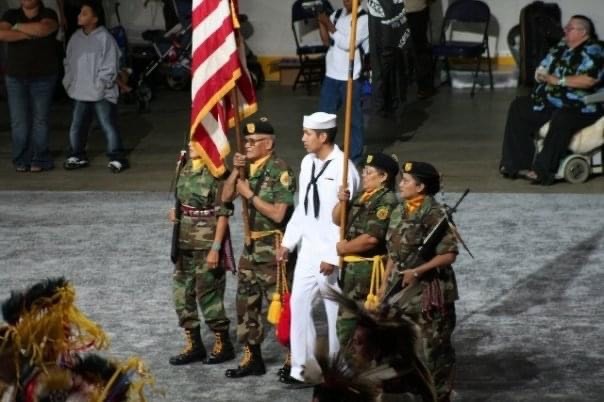Kim Brooks, Marine Corps Veteran and Proudly She Served portrait participant, shares about the the origins of her unique military uniform in the Proudly She Served portrait series. After receiving a question about her uniform on social media, Kim was inspired to educate those not familiar with Native American Color Guards or customs.
"The uniform that Steve has painted is my Native American Color Guard uniform. Many different Native American Tribes have different uniforms. Within the Native American community, all Veterans and their families are held with high esteem. This is a long standing tradition to honor the warriors who have given themselves to protect the people. Within the Native American community, we still hold our traditional gatherings, some formal and some informal. One example of a Native American Color guard function today is participation in a Powwow. This tradition is usually open to the public. It's a time for us to gather as one, to dance, play our drums and sing our songs. At one dark time in American history these dances, gatherings, and songs were banned. Even our languages were forbidden to be spoken. Today we proudly hold tight to these traditions so that we may pass it along to our future generations.
A traditional Powwow normally starts off with the blessing of the ground in which the dancers and participants will be dancing. The Master of Ceremonies (MC) will then direct one of the drum groups to start singing and drumming and then the event kicks off with the "The Grand Entry." The "Grand Entry" is when everyone who is participating will come into the circle and dance their way in. The first to come into the circle is the Native American Color Guards. We carry the Eagle Staff which is the equivalent of the American Flag to our people. We also carry the American Flag and POW flag and any other tribal flags for that particular Powwow or gathering. The color guards consist of Native American and sometimes non-native veterans.
Next to follow is the Head Lady and Head Male dancer and then tribal leaders and then the individual break down of each style of dancing group. Once everyone has entered the circle, the drums will silence and the MC will welcome everyone and a blessing is given in our Native tongues, after which the MC will direct one of the drum groups to play an Honor Song to Honor ALL Veterans. The Colorguard will remain standing for the rest of the procession will come and shake each of the color guards' hands to honor them. After the last person has shaken the last hand and exited, the Colorguard will then begin to march and dance around the circle. At this time the MC will usually call out ALL VETERANS, both Native and Non-Native alike and he will call out the different wars and eras and ask for those veterans who served during that time and their families to come and join the dance in the circle. Each veteran or family member will enter and shake the hand of the Color Guard and any others who have already entered the circle.
Only a member who is on Active Duty is allowed to wear the full official military uniform. Veterans will wear their Color Guard uniforms, which will consist of parts of the military uniform or patches or covers whatever the Color Guard has decided. The founders of the Color Guard were both Vietnam Native American veterans. So it is adorned with the Color Guard patch and an Eagle Feather which was gifted to me from a Vietnam Marine Combat veteran.
Eagle feathers are sacred to our people and only Native Americans are allowed to legally own them. My earrings are Navajo (Dine) which were also gifted to me. My neck is a yellow scarf and where my chevrons would normally go is a pair of cross arrows. In Native American Color Guards there is no rank; we are all equal. On my left shoulder is the Native American Color Guard patch which reads "Honor-Color Guard, Vietnam Veterans Inter-Tribal Association." On my right breast pocket is another patch that reads "American POW-MIAs of Vietnam, Still missing but not forgotten." My belt was also gifted to me by one of the late co-founders, Mr. Begay, a Navajo.
The Navajo and my tribe, Koyukon Athabascan, are both Dine and are directly related to each other and we both believe at one time we were one people. They refer to us as the "Far North People" and our languages and clan structures are similar. Mr. Begay would always joke around and say, “She’s Athabascan but she’s actually really Navajo”. My gloves in the painting are from my Auntie, which are traditional moose skin and adorned with beaver fur, and have a beaded American Flag. Instead of boots I am wearing my Mukluks, which were made by my late Grandmother Janie before her death. They are made of Caribou skin.
This uniform is a Native American Color Guard uniform, unique for Native Americans. I am extremely honored to wear it with pride and dignity. The pictures are from the National Powwow and also during the National Veterans Day Parade in Washington DC."



